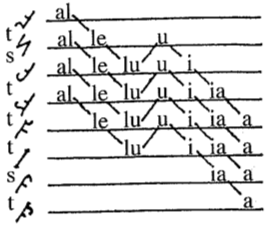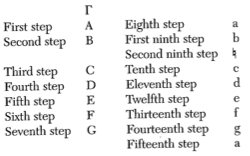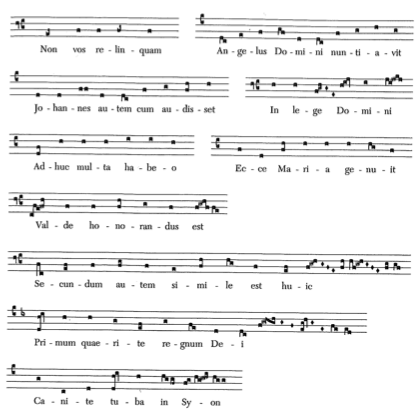Notation Reforms
At the end of Tuesday's lecture, we looked at the Seikilos song in conventional notation. We broke the notation down into its components: the clef, the staff, the time signature, the key signature, barlines, and so on. Each of these graphic elements has its own history. The oldest, such as the staff, have existed for over a thousand years, while the youngest, such as the standardized system of key signatures, articulation marks, and crescendo and diminuendo signs, and have been around for only a few centuries. The apparent homogeneity of conventional notation is therefore an illusion, at least from the historical perspective. If it appears transparent and complete to us, that has nothing to do with an inherent property of the notation itself, but rather the role it plays in our musical training and education. Through the eyes of musicians who can only read conventional notation, the history of notation seems to be the progress from ancient illegibility and disorder to modern legibility and reason. But these musicians are wrong to compliment themselves by supposing that the musicians of the past grappled in obscurity, while their own literacy is the enlightenment of proper musical vision. They are at least half wrong: their literacy, like that of their predecessors, is vision and blindness in equal measure.
We can only understand the technical dimension of notation if we understand that the visibility of a musical inscription is simultaneously the invisibility or exclusion of its alternatives. Just as an oscillator circuit is not Max/MSP in its infancy, but rather a distinct technology with distinct expressive possibilities, 12th-century notation is not 20th-century notation waiting to clean itself up and realize its full potential. More powerful, technologically-advanced tools do not reveal more compositional possibilities; they can only shift compositional focus by hiding something that was visible before. In making their parameters and musical ideas visible, both Earle Brown and Stockhausen rendered their work illegible to musicians who could read only notes. As we shall see, the same is true to the musicians of the 12th and 14th centuries, who likewise had to turn a blind eye to their own conventions before seeing the alternatives.
Today, we look at several examples of notation reform. We avoid imposing the conventional wisdom of notation's progress, of its increasing scope and expressive power. Instead, we explore its shifting field of musical visibility. With each example, we account not only for what appeared on the musical page, but also for what had to disappear as a consequence. Sometimes the vision of composers and musicians shifts from one point of focus to another, as they turn away entirely from an older tradition. But even in cases when a new notation seems to encompass an older system and enlarge its resources, the focus of musical vision still shifts. One can only perceive a landscape in its entirety by overlooking its details; in the same way, the older system of notation loses its distinction in its newer, enlarged context, and seems narrow only in retrospect. A shift of attention from the veins of a leaf to the contours of a forest is not progress. It is a matter of framing.
1. Staff and musical alphabet
Let's begin at the beginning. The first decisive event in the history of European notation was the first act of musical inscription, which, as we saw on Teusday, produced what in retrospect we call "staffless neumes." The name reveals that notation in the retrospective light of the second decisive event: namely, the reinvention (or rediscovery) of the musical alphabet and the invention of the staff. In the ninth century, the anonymous author of the Musica Enchiriadis put Western music on the grid with a Greek-inspired notation system, now called daseian notation. It involves a fixed scale of whole steps and half steps, symbols designating steps within this scale, and staff lines corresponding to each step. The following example from the text shows four transpositions of an "alleluia" splayed open on an eight-line staff, which we can interpret as a white-note scale from D to D:

Alleluia phrase in daseian notation. The "t" and "s" markings on the left-hand side indicate tones (whole steps) and semitones (half steps). [1]
| [1] | Source Readings in Music History, ed. Oliver Strunk, Vol. 2, page 84. |
The cumbersome staff and unfamiliar symbols of daseian notation set the stage for the musical alphabet and staff that Pseudo-Odo of Cluny described in the tenth century, and that remain the basis of conventional notation:

Musical alphabet, from Pseudo-Odo of Cluny's "Dialogue on Music." The whole- and half-steps between the letters correspond to modern practice. [2]
| [2] | Ibid., 92. |

Examples of neumes on a four-line staff with F and C clefs, from the same source. [3]
| [3] | Ibid., 93. |
Europe had lost sight of discrete pitches for almost a thousand years; the staff and musical alphabet made them visible yet again. Insofar as these inventions produced extraordinary insight, however, they also caused a catastrophic loss of vision. The grid of pitch does not accommodate sliding around, and all the fluid, ornamental forms of the earlier notation disappeared; they were replaced by discrete and well-defined shapes. This disappearance produced a corresponding deafness. At some point, after plainchant had become a tradition passed on by notation rather than by ear, musicians simply forgot what the staffless neumes sounded like. They could only reproduce what the notation made legible. In the case of the staffless neumes, this means nothing at all, because no one bothered to explain how to read it; in the case of the staffed neumes, it means discrete pitches only, because that's what's on the page. This is clear from today's plainchant recordings, the plainness and monotony of which (whether pleasant or not) reflect the notation:
- YouTube performance of a Gregorian chant, with video of the score: http://www.youtube.com/watch?v=LmUWbLNrlrY&feature=related
Pitch is one of the fundamental acoustic parameters. It is linear, like the string of the monochord the ancient Greeks and medieval Europeans used to measure it. Those who perceive such linearity lose sight of non-linear musical concepts that hover between acoustic categories—concepts such as accent, which may be a matter of pitch, of dynamic, of time, or of timbre. Following the gaze of the Greeks, the Europeans of the ninth century not only glanced upon their first musical line, but also saw it divided into discrete segments, broken into steps and scales and tallied with symbols. At this moment they lost sight of the staffless neumes.
2. Plainchant to modal rhythm
The third event in the history of notation is another imposition of acoustic linearity, and another shift of perspective from the continuous to the discrete. If there had been rhythmic proportions in plainchant, they are now forgotten; as we just heard, singers today follow the metric logic of the text they chant. In the twelfth century, musicians discovered that time could exist on a line as well, that they could measure it and break it into units. The definition of "measurability" by an anonymous author attests both to this new knowledge and to the confusions it produces:

Ibid., 109.
While this convoluted definition of temporal division may be mathematically or physically defective, it produces a particular rhythmic aesthetic. Muddled science may reduce the scope of music notation, but, as stated before, this is no argument against it. The earliest rhythmic notation constitutes a sort of hardware-hacked time, capable of producing only six patterns, all of which are in what we consider 6/8:
The six rhythmic modes, as they appear in Johannes de Garlandia's De musica mensurabili (Ibid., 113)






But 6 patterns is all you need:
- Pérotin: Viderunt Omnes with score: http://www.youtube.com/watch?v=bpgaEFmdFcM
(Minimal resources produce a minimalist aesthetic, and it is no surprise that the music of Pérotin inspired Steve Reich, whose "Clapping Music" we performed before the spring break.)
Again, we should consider not only what the rhythmic notation of the Ars Antiqua made visible, but also what it rendered invisible. Just as the staff was incompatible with the smooth, unmeasured curves of the first neumes, so were the rhythmic modes at odds with an earlier notation system that simply did not consider time as an independent linear parameter. In polyphonic music, the irregular and inconsistent rhythms of speech disappeared.
With pitch and time now represented as linear parameters, composers could generate musical patterns and relationships through calculations. Musical objects became mathematical objects. If mathematics is essential to European music, however, it is not because it is essential to music in general, but rather because these momentous events in the early history of notation and musical thought forced math and music to collide. Despite what most people think, but as have amply and perhaps excessively demonstrated in this class, one does not need to know how to keep a beat or to sing in tune to make music. By the twelfth century, however, the problems of music-making had become problems of counting beats and harmonizing. Notation attests to this conflation, by illuminating the units of pitch and time against which European music will measure itself until the twentieth century.
3. Modal rhythm to mensural rhythm
First, staffless neumes; second, neumes on a staff; third, the rhythmic modes of the ars antiqua: three events, each of which altered the composer's field of vision. In the thirteenth century, the polyphony of Pérotin became old; the ars nova, or new art, turned away from its rhythmic modes to gaze upon a proportional notation resembling our own. Rhythmic patterns became not only representable, but manipulatable.
The new notation could not only reproduce the six gig-like modal rhythms of old, but could also represent patterns that were inconceivable in the old system: for example, duple rhythms, called "imperfect" because they lacked the "perfection" of compound (i.e. triple) rhythms, which reflected the Holy Trinity.
- Machaut's "De toutes flours": http://www.youtube.com/watch?v=TZiVV5i3sMU&feature=related
- Machaut Mass of Notre Dame with score: http://www.youtube.com/watch?v=1Y1O-BcZQwY
[Ad-libbed conclusion]
Jacques of Liege (late 13th–early 14th c.)
To some, perhaps, the modern art will seem more perfect than the ancient, because it seems more subtle and more difficult. It appears to be more subtle because it reaches out further and makes many additions to the old art, as is evident in the notes and measures and modes (for the word subtle is used of that which is more penetrating, reaching out further). That it is more difficult may be seen in the manner of singing and of dividing the measure in the works of the moderns.
To others, however, the opposite seems true, for that art appears to be more perfect which follows its basic principle more closely and goes against it less. Now the art of mensural music is based on perfection, as not only the ancients but the moderns declare. Therefore whichever makes the greater use of perfection appears to be the more perfect; and this is true of the ancient art, the art of Master Franco.
For the new art, as we have seen, uses maifold and various imperfections in its notes, modes, and measures. Imperfection intrudes virtually everywhere: not content with imperfecting notes, modes, and measures, it extends itself to the tempus. For the new art has what it calls imperfect time, and has breves which it calls imperfect in regard to time, a thing unknown to the old art. And it applies an imperfection arising from time to the notes of the individual degrees: to simple, duplex, and also triplex longs; to breves, while some apply it even to semibreves.
The practitioners of this art are still inventing new ways of imperfecting what is perfect. . . . Nor are the moderns satisfied with making perfect notes imperfect and dragging them to imperfection; they must do this even with the imperfect notes, since they are not content with a single imperfection, but require many. (Ibid. 161–162)